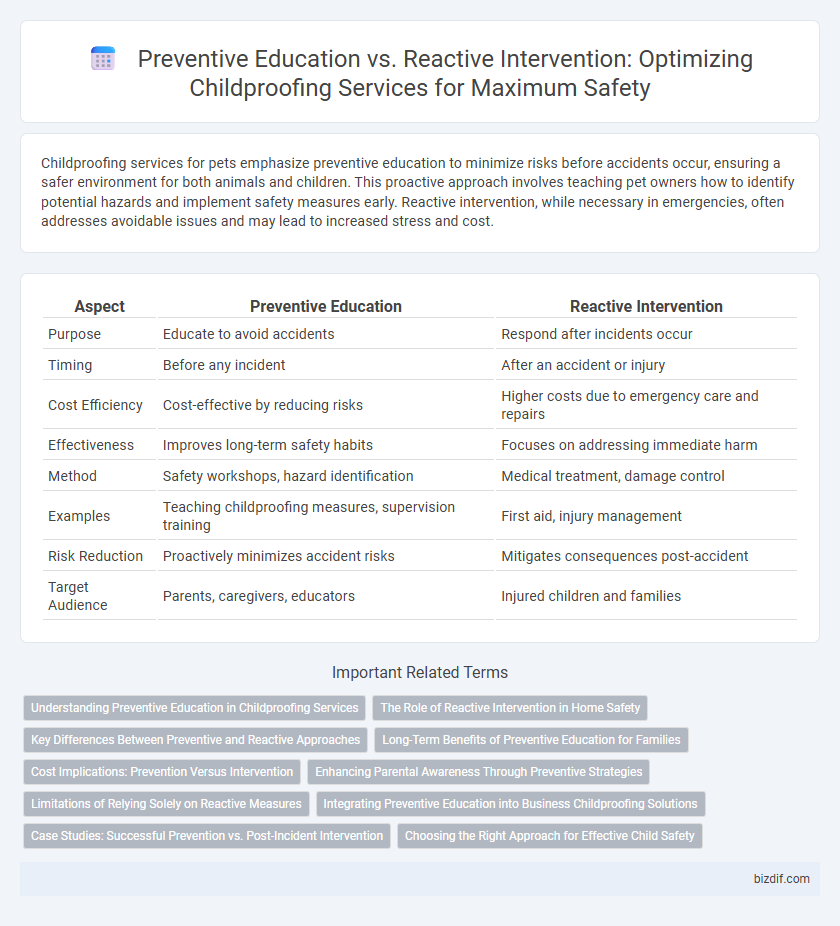Childproofing services for pets emphasize preventive education to minimize risks before accidents occur, ensuring a safer environment for both animals and children. This proactive approach involves teaching pet owners how to identify potential hazards and implement safety measures early. Reactive intervention, while necessary in emergencies, often addresses avoidable issues and may lead to increased stress and cost.
Table of Comparison
| Aspect | Preventive Education | Reactive Intervention |
|---|---|---|
| Purpose | Educate to avoid accidents | Respond after incidents occur |
| Timing | Before any incident | After an accident or injury |
| Cost Efficiency | Cost-effective by reducing risks | Higher costs due to emergency care and repairs |
| Effectiveness | Improves long-term safety habits | Focuses on addressing immediate harm |
| Method | Safety workshops, hazard identification | Medical treatment, damage control |
| Examples | Teaching childproofing measures, supervision training | First aid, injury management |
| Risk Reduction | Proactively minimizes accident risks | Mitigates consequences post-accident |
| Target Audience | Parents, caregivers, educators | Injured children and families |
Understanding Preventive Education in Childproofing Services
Preventive education in childproofing services empowers parents and caregivers with knowledge and practical strategies to anticipate and eliminate potential hazards before accidents occur, significantly reducing the risk of injury. This proactive approach involves detailed safety assessments and personalized guidance on securing furniture, electrical outlets, and toxic substances, fostering a safer home environment. Emphasizing preventive education enhances long-term child safety by promoting continuous awareness and vigilance rather than responding only after an incident.
The Role of Reactive Intervention in Home Safety
Reactive intervention in home safety plays a critical role by addressing hazards promptly after an incident or near-miss, minimizing potential injuries to children. It involves immediate actions such as repairing broken safety devices, reinforcing secure locks, and educating caregivers on responses to emergencies. This approach complements preventive education by ensuring that unforeseen risks are managed effectively to maintain a secure environment.
Key Differences Between Preventive and Reactive Approaches
Preventive education in childproofing emphasizes proactive strategies such as safety training and hazard identification to reduce the risk of accidents before they occur, whereas reactive intervention deals with responses and corrections after incidents happen. Key differences include timing, with preventive measures implemented early and consistently, and reactive methods addressing consequences and repair. Preventive approaches often lead to long-term safety improvements, while reactive interventions primarily manage immediate risks and recovery.
Long-Term Benefits of Preventive Education for Families
Preventive education in childproofing equips families with essential knowledge and skills to create safer environments, significantly reducing the risk of accidents and injuries over time. This proactive approach fosters lasting habits and awareness that protect children as they grow, minimizing the need for costly and stressful reactive interventions. Families investing in preventive education experience greater peace of mind and long-term health benefits, ensuring children's safety and well-being well into the future.
Cost Implications: Prevention Versus Intervention
Investing in childproofing preventive education significantly reduces long-term costs by minimizing the risk of accidents and medical emergencies, which often require expensive reactive interventions. Proactive measures such as safety training and hazard assessments deter hazardous situations, saving families and service providers considerable expenses related to emergency response, treatment, and legal liabilities. Data shows that every dollar spent on preventive child safety education can save multiple dollars in potential intervention and recovery costs, highlighting the economic efficiency of prevention over intervention.
Enhancing Parental Awareness Through Preventive Strategies
Enhancing parental awareness through preventive strategies significantly reduces the risk of childhood accidents by educating caregivers on potential hazards before incidents occur. Preventive education empowers parents with practical knowledge on childproofing techniques, fostering a proactive mindset rather than relying on reactive intervention after an injury. Studies show that families engaged in preventive education report fewer emergency interventions, highlighting the effectiveness of anticipatory safety measures in childproofing services.
Limitations of Relying Solely on Reactive Measures
Relying solely on reactive intervention in childproofing limits the effectiveness of safety measures, as it addresses hazards only after incidents occur. Preventive education empowers caregivers with proactive strategies to identify and mitigate risks before accidents happen, reducing injury rates significantly. Studies show that homes implementing preventive childproofing education experience fewer emergency interventions and improved overall child safety outcomes.
Integrating Preventive Education into Business Childproofing Solutions
Integrating preventive education into business childproofing solutions significantly reduces accident risks by empowering employees and parents with proactive safety knowledge. Emphasizing hazard identification and safety protocols before incidents occur creates a safer environment and minimizes costly reactive interventions. Incorporating comprehensive training modules within childproofing services enhances overall workplace safety culture and safeguards children effectively.
Case Studies: Successful Prevention vs. Post-Incident Intervention
Case studies in childproofing highlight that preventive education significantly reduces household accidents by equipping parents with knowledge to mitigate risks before incidents occur. In contrast, reactive interventions often involve costly medical treatments and emotional distress after an injury, demonstrating a less effective approach in safeguarding children. Data shows homes with proactive childproofing education experience a 40% lower rate of emergency room visits related to preventable injuries.
Choosing the Right Approach for Effective Child Safety
Preventive education in childproofing emphasizes proactive measures such as teaching children about potential hazards and securing the environment before incidents occur. Reactive intervention involves responding to accidents after they happen, often requiring emergency responses and medical treatment. Prioritizing preventive education ensures long-term child safety by reducing risks and fostering awareness, making it the most effective approach for comprehensive childproofing strategies.
Preventive Education vs Reactive Intervention Infographic

 bizdif.com
bizdif.com